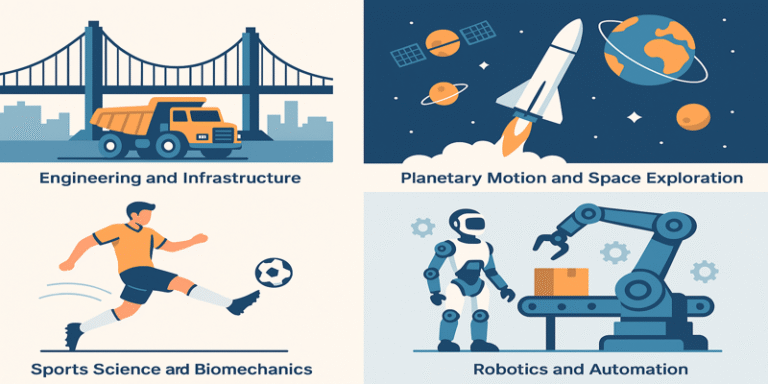Though developed over three centuries ago, classical mechanics remains an indispensable tool across numerous scientific and engineering domains. Rooted in Newtonian principles, classical mechanics provides the framework for understanding how objects move and interact under the influence of forces. From structural design and space exploration to sports biomechanics and robotics, this discipline continues to power modern innovation and technological development.
Despite the advent of quantum mechanics and relativity, the scope of classical mechanics is vast and sufficient for most macroscopic systems involving moderate speeds and everyday scales.
1.0 Engineering and Infrastructure
One of the most visible applications of classical mechanics is in civil and mechanical engineering, where it is used to design and analyse structures such as bridges, buildings, vehicles, and mechanical systems. Engineers rely on principles such as static equilibrium, stress and strain analysis, torsion, and beam bending theory to ensure safety, stability, and longevity.
According to Hibbeler (2016), classical mechanics is foundational for:
- Calculating load-bearing capacity of beams and trusses.
- Determining support reactions and internal forces.
- Ensuring resonance does not occur under dynamic loading (e.g., earthquakes, winds).
For example, the design of suspension bridges involves a careful balance of tensile and compressive forces, ensuring that the bridge remains stable under variable traffic and weather conditions.
In mechanical engineering, the motion of parts within engines, gear systems, and hydraulic lifts are governed by Newtonian equations. This enables predictive design for both performance and failure prevention.
2.0 Planetary Motion and Space Exploration
Classical mechanics remains vital in astronomy and aerospace engineering, especially in contexts where relativistic effects are negligible.
The laws of planetary motion, developed by Kepler and explained through Newton’s law of universal gravitation, still underpin the prediction of:
- Planetary orbits
- Eclipses
- Lunar cycles
- Satellite trajectories
Smart & Green (2013) illustrate how Kepler’s laws, when combined with Newton’s law of gravitation, enable mission planners to determine satellite orbits and interplanetary transfer paths. For example, space agencies use Hohmann transfer orbits, derived entirely from classical mechanics, to send probes to Mars or the Moon.
Modern missions such as Mars rovers, GPS satellites, and international space launches all begin with trajectory planning based on Newtonian dynamics before refining with relativistic corrections if needed.
Furthermore, rocketry depends on Newton’s third law—for every action, there is an equal and opposite reaction—which explains how expelled gases push a rocket forward in space (Giancoli, 2008).
3.0 Sports Science and Biomechanics
Classical mechanics is increasingly used in sports science to improve performance and prevent injuries. It helps researchers and trainers analyse how forces act on the human body during movement.
According to McGinnis (2020), applications include:
- Projectile motion to study ball trajectories (football, cricket, tennis).
- Torque and angular momentum in spinning athletes (divers, gymnasts, figure skaters).
- Impact forces during running, landing, or collisions in contact sports.
- Work and power output in strength and endurance exercises.
For example, biomechanical models of the golf swing or tennis serve allow athletes to identify inefficient movements and refine technique. Coaches use motion capture systems, underpinned by Newtonian equations, to break down motion into measurable components like velocity, acceleration, and force.
In injury prevention, understanding ground reaction forces and joint moments enables the development of better training regimes and safety equipment. Tools such as force plates and wearable sensors provide real-time data analysed using classical principles.
4.0 Robotics and Automation
In the field of robotics, classical mechanics plays a central role in modelling and controlling robotic systems. Robots, whether industrial arms or autonomous vehicles, must be programmed to interact with a physical world governed by Newtonian laws.
Spong et al. (2020) explain that classical mechanics is critical in:
- Kinematic modelling: Determining position, velocity, and acceleration of robot links.
- Dynamic modelling: Calculating joint torques and forces.
- Trajectory planning: Ensuring robots follow desired paths with stability.
- Force control: Allowing robots to grip objects or interact safely with humans.
For instance, an autonomous robot vacuum must predict how it will accelerate or decelerate in response to floor friction or obstacle impact. These responses are determined using Newton’s second law: F = ma.
In robotic manipulators, understanding joint torques and inertial loads is essential for stability and accuracy. Classical mechanics also guides the development of humanoid robots, prosthetics, and exoskeletons, where force control is crucial to mimic human motion effectively.
5.0 Other Modern Applications
Education and Simulation
Classical mechanics remains a core component of secondary and university curricula. It introduces students to fundamental concepts like:
- Linear and rotational motion
- Friction and energy conservation
- Momentum and collisions
Physics simulations and virtual labs increasingly use interactive models based on Newton’s laws to teach concepts more effectively (Knight, 2016).
Vehicle Safety and Crash Modelling
In automotive engineering, crash simulations rely on conservation of momentum, impulse, and force-time relationships to design safer vehicles. The way a car crumples upon impact is engineered using classical principles to reduce the force transmitted to occupants.
Virtual Reality and Game Physics
Game developers use simplified models from classical mechanics to simulate realistic environments. From character motion to projectile weapons, virtual physics engines apply kinematics and dynamics equations to create immersive and accurate gameplay (Eberly, 2003).
Despite the rise of quantum and relativistic theories, classical mechanics continues to offer a robust and versatile framework for real-world problems. Its applications extend far beyond textbooks—into the arenas of engineering, sports, aerospace, and robotics.
The strength of classical mechanics lies in its clarity, predictability, and computational simplicity. Its principles, particularly Newton’s laws of motion and gravitational theory, remain cornerstones in the scientific and technological world. In every robot arm, sports analysis tool, or spacecraft launch, Newton’s legacy continues to move us forward—both literally and figuratively.
References
Eberly, D. (2003) Game Physics. San Francisco: Morgan Kaufmann.
Giancoli, D.C. (2008) Physics: Principles with Applications. 6th ed. Pearson Education.
Hibbeler, R.C. (2016) Engineering Mechanics: Statics and Dynamics. 14th ed. Pearson.
Knight, R.D. (2016) Physics for Scientists and Engineers: A Strategic Approach. 4th ed. Pearson.
McGinnis, P.M. (2020) Biomechanics of Sport and Exercise. 3rd ed. Human Kinetics.
Smart, W.M. & Green, R.M. (2013) Textbook on Spherical Astronomy. 6th ed. Cambridge University Press.
Spong, M.W., Hutchinson, S. & Vidyasagar, M. (2020) Robot Modeling and Control. 2nd ed. Wiley.









